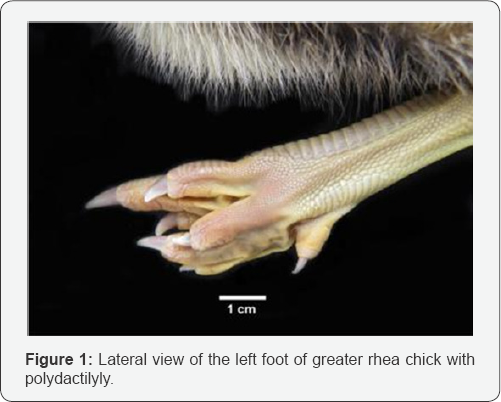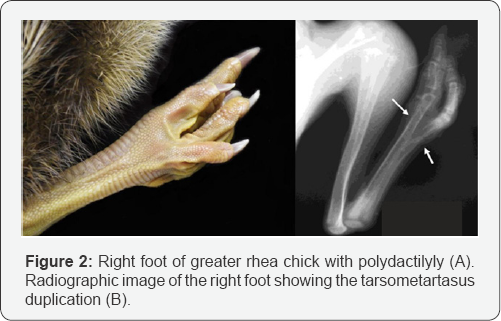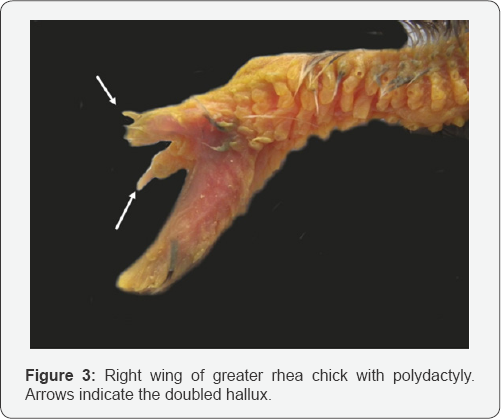Tarsus-Metarsus Duplication and Polydactyly in Wild Greater Rhea, Rhea Americana, from South Brazil - Case Report-Juniper Publishers
Journal of Dairy & Veterinary Sciences- Juniper Publishers

Introduction
Polydactyly is a well studied congenital deformities observed in newborns that may involves the presence of more than the usual number of digits mainly in the upper extremities. In animals, this condition is recorded in several species such cats, dogs, guinea pigs, fowl, tortoises and birds [1-3]. It is important to note that each species has its own unique characteristics and different modes of inheritance. Polydactyly in the cat is most similar to that seen in the fowl, with exception of the mirror imaging seen in the latter [3]. In birds, this anomaly is caused due to the expression of a dominant autossomicalel [4] being recorded in chicken and rapine birds [3-5]. The greater rhea, Rhea Americana, is a common species in Brazil. Five subspecies are recognized being Rhea Americana intermedius those found in wild population from southeastern Brazil and Uruguay [6,7]. Rheas are great birds that have not flight capacity. Unlike most birds there have only three digits in the foot [8] and the absence of the halux (alula) in the forelimbs [9]. None published data about polydactyly in rheas was found. This paper reports a case of polydactyly in chicken greater rhea, from the municipality of Rio Grande, Rio Grande do Sul State, Brazil (32°02’26S-52°18’130) conducted to the Center for Rehabilitation of Wildlife (NURFS- CETAS-IBAMA) from Federal University of Pelotas (UFPEL).
Case Details
The bird was found by a farmer and have about two weeks of age. The animal could not sustain the body on its legs and had strong bilateral ankylosis in the lateral tarsal-metatarsal joints. The bird was radio graphed and the veterinarians decided for euthanasia and necropsy. Anatomical dissections of the fore and hind limbs were performed. The corpse of a normal specimen with same age was also dissected and used as reference. The organs of the bird with mal-formations have not presented other morphological changes or pathologies than those found in the limbs. In both feet was observed the presenceof tarsal-metatarsal bones partially duplicate and the presence of six fingers in the right foot and seven in the left one (Figure 1). Radiographic image is presented in the Figure 2. Presence of the hallux in the left wing was observed. In the right wing, the specimen showed doubling of this finger (hallux) (Figure 3).



Discussion
Limbs deformities including tibiotarsal rotation and rolled toes have been recorded in farmed ostrich chicks [10]. These malformations may be attributed to the genetic failure, nutritional deficiency and unsuitable housing of eggs during the incubation period [8]. The incidence of this problems is eventual and the specific etiology is already unknown [8]. Rheas are taxonomically distinct of ostriches, they are known to have three fingers and tarso-metatarsus with three pairs of condyles, each hinged to a finger. They are anisodactyl birds with absence of the hallux. No previous record of polydactyl was found in the greater rhea, although they have been cited in Strutio camellus [10,11]. In fowls (Gallus g. domesticus) similar description of polydactyly was described as “duplicate” because of the apparent duplication of the foot and toe. In that species duplication of the alulae also occurs, such as that observed in this study and the anomaly is usually lethal and derived from a homozygous dominant gene [4,12]. Special attention should be done to specimens coming from a wild population, with the control of the occurrence of new cases in order to assess possible changes in gene frequencies in natural populations.
To know more about journal of veterinary science impact factor: https://juniperpublishers.com/jdvs/index.php
To know more about Open Access Publishers: Juniper Publishers


Comments
Post a Comment